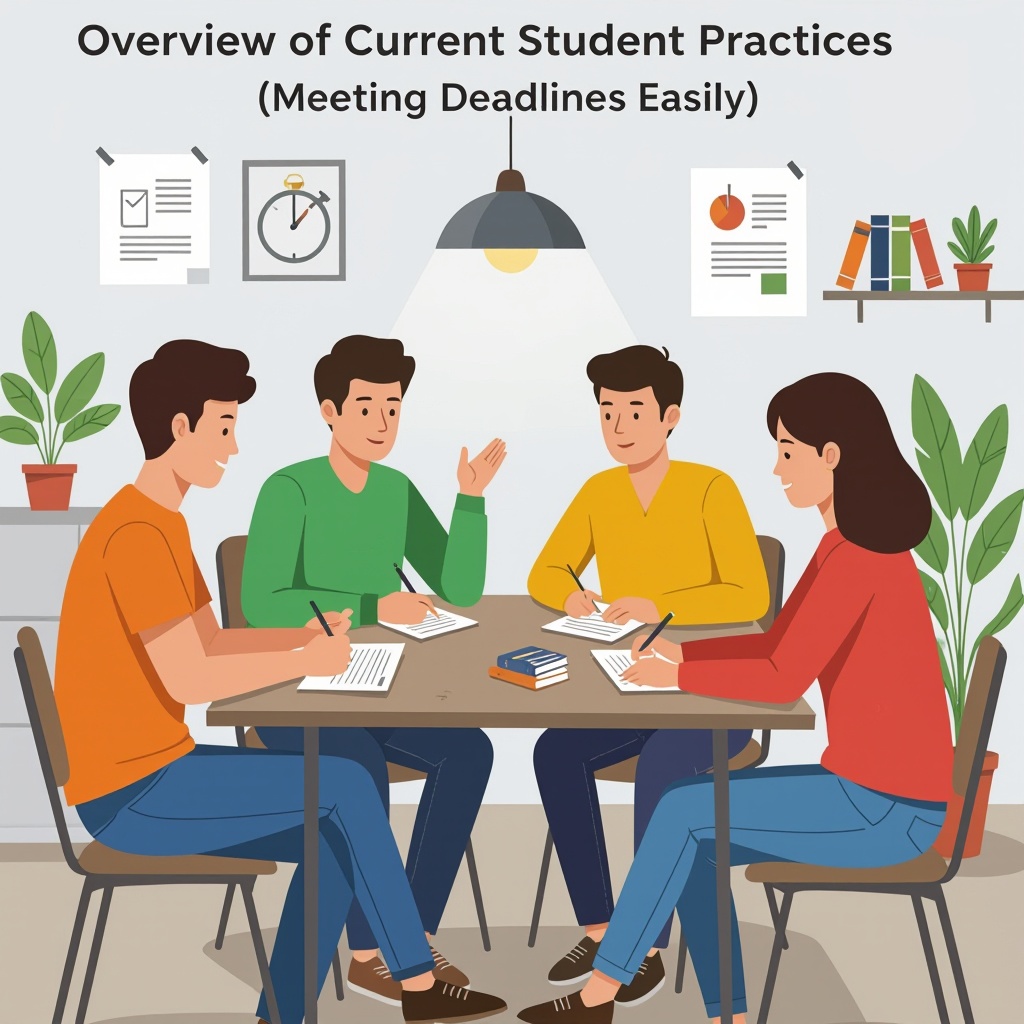Managing time for assignments can be particularly challenging for many students as they navigate the complexities of academic demands. A significant number of students struggle to balance their coursework, extracurricular activities, and personal responsibilities, often finding themselves overwhelmed and resorting to procrastination. However, by incorporating structured methods and tools, students can significantly improve their ability to tackle assignments efficiently, meet deadlines consistently, and boost their overall academic performance. This proactive approach not only enhances their work quality but also considerably reduces stress levels, leading to a more fulfilling and less pressured academic experience. By adopting effective time management techniques, students can transform how they handle their coursework, gaining more control and confidence in their academic journey.
Overview of Current Student Practices
A significant number of students face challenges with handling their time effectively. It’s quite telling that about 86% of undergraduates express difficulties in this area. This struggle often results in a cycle of procrastination and rushing just before deadlines.
Many students—around 82%—also don’t use any method or tool to help organize their schedules. This absence of a system leaves them vulnerable to distractions and makes it harder to prioritize tasks. As a result, they frequently submit their assignments past due dates.
Understanding these statistics highlights the importance of using tools and methods that can help balance academic demands. By doing so, students can develop a structured approach that not only helps them meet deadlines but also reduces stress and improves overall performance. While managing time comes across as challenging at first, incorporating even simple strategies or apps into daily routines can make a substantial difference.

Consequences of Procrastination
Procrastinating can significantly impact academic performance. Research shows that 76% of students submitting assignments ahead of deadlines earn higher marks than the 60% who delay (Smith Academic Research). This highlights how crucial managing time effectively can be. Those who plan and execute their study schedules efficiently tend to achieve better scores, underscoring a strong correlation between time management and academic success.
Procrastination often leads to rushed assignments, leaving little room for critical reflection or revision. Early submitters benefit from the opportunity to proofread and refine their work. They can also seek feedback and revise accordingly, honing the quality of their assignments. Meanwhile, those submitting at the last minute may miss these strategic opportunities for improvement.
Balancing academic priorities and breaking tasks into manageable parts can combat procrastination. By allocating specific times for research, drafting, and revision, students can enhance the quality and timeliness of their work. The benefits of this structured approach significantly outweigh the short-term comfort procrastination might offer.
Encouraging early submission is key. Emphasizing the advantages can motivate students to adopt more organized study habits, increasing their potential for academic achievement. Fostering an understanding of these consequences not only improves grades but also builds essential life skills in time management.

Effective Techniques for Breaking Down Large Tasks
I’ve found that dividing assignments into smaller tasks can really help make things feel less overwhelming. It usually leads to starting earlier too. By tackling bits at a time, I see progress without feeling swamped. Here’s how I break it down:
Planning Stage:
Begin by understanding what the assignment requires. Use these pointers:
- Identify the main objectives.
- List resources you’ll need.
- Set a timeline for each section.
Once the planning is done, it’s time to move on to gathering information.
Researching Stage:
Collect relevant data and resources. This stage forms the foundation, so ensure accuracy and depth. Here’s how:
- Use trustworthy sources.
- Organize notes clearly for easy reference.
Next, transferring research into structured ideas comes into play.
Drafting Stage:
Drafting involves putting ideas into words. Writing early drafts helps organize thoughts clearly. Focus on:
- Creating a coherent flow of information.
- Allowing room for ideas to evolve.
After drafting, improve the content for clarity and precision.
Editing Stage:
Edit with a sharp eye, ensuring ideas are concise. Consider:
- Removing unnecessary content.
- Refining language for readability.
Finally, make sure everything meets requirements.
Final Checking Stage:
Wrap up by reviewing the assignment for any remaining errors. This includes:
- Checking formatting and referencing requirements.
- Reviewing feedback from previous tasks for improvement.
Breaking tasks into these stages makes large assignments less intimidating. Starting early becomes a natural result, significantly easing deadline pressure.
Scheduling Incremental Deadlines
Successfully managing assignment deadlines involves breaking the task into smaller, achievable goals. Let’s say you’ve got a research paper due in two months. You’d first set a weekly goal to ensure ongoing progress. In the initial weeks, focus on gathering and reviewing sources. By the end of the first month, aim to complete an outline and a draft. You’re not just moving closer to the final submission, but also creating opportunities for feedback and refinement.
During the second month, schedule a goal to refine each section weekly. It’s a wise move, as this allows time to perfect arguments and enhance the quality of writing. If required, allot specific weeks to incorporate feedback. Doing this simplifies complex assignments into manageable parts, effectively reducing stress.
Consider this approach for any major assignment:
- In the first few weeks, gather research sources.
- By the first month’s end, complete a comprehensive draft.
- Allocate the second month for refining and finalizing details.
- Set aside specific times for receiving and incorporating feedback.
Incrementally setting these deadlines creates a clear roadmap to completion. Each completed task brings a sense of achievement and keeps motivation high. Overall, this method turns a potentially overwhelming project into a series of simple, clear tasks. Regularly meeting smaller deadlines develops discipline, greatly improving time management skills. You’ll find assignments become more manageable, and deadlines are less intimidating.
Popular Time Management Methods and Best Practices
One effective approach to managing time is the Eisenhower Matrix. It’s a tool that helps prioritize tasks by dividing them into four categories: urgent and important, important but not urgent, urgent but not important, and neither urgent nor important. According to the Eisenhower Matrix Organization, 100% of users feel more in control of their schedule after utilizing this method.
Another method worth considering is the Pomodoro Technique. This system involves breaking work into 25-minute intervals, called “Pomodoros,” separated by short breaks. This can prevent burnout and enhance focus. Studies show that 60% of those using the Pomodoro Technique report improved task efficiency.
For best practices:
- Prioritize tasks effectively.
- Set specific time blocks for studying.
- Include breaks to maintain focus.
- Use tools and techniques consistently for better results.

Common Tools and Systems
To-do lists are everywhere when it comes to organizing assignments. They’re quick to create and offer a visual reminder of tasks. However, without structure, they often result in incomplete tasks and increased stress. Informal systems, like sticky notes and impromptu reminders, are popular and easy to use. But, these can leave you scattered and overwhelmed.
For a more efficient approach, consider integrating structured digital tools. Apps like Trello or Asana offer organized task management with deadlines and priorities. They not only keep you on track but also simplify managing workloads. Unlike traditional to-do lists, these platforms enhance productivity by allowing you to see the bigger picture of your tasks. A clear, digitalized system minimizes the chaos, leading to reduced stress and a better handle on deadlines.

Prioritizing Assignments to Achieve Efficiency
Successfully managing your time often hinges on how well you prioritize tasks. To tackle assignments effectively, focus on deadlines and potential grade outcomes. This strategy helps you concentrate on assignments that matter most.
Start with a clear overview of all your assignments. Create a list where each task’s due date and weight toward your final grade are visible. Highlight the most urgent deadlines and assignments that carry the most weight. This clear snapshot lets you allocate your time and effort wisely.
If you’re juggling multiple tasks, it’s wise to address those with the earliest deadlines first. Pay special attention to assignments that substantially impact your grade. Often, spending extra time on high-value assignments pays off more than dividing attention equally across all tasks.
Consider using a priority matrix method. It allows you to categorize tasks into four groups:
- Important and urgent: Need immediate attention, suitable for top priority.
- Important but not urgent: Should be scheduled into your agenda.
- Urgent but not important: Delegate if possible, or minimize time spent.
- Neither important nor urgent: Consider eliminating or doing later.
By adhering to this method, you’ll find yourself tackling work more efficiently. Remember, the goal is to maximize your academic performance by dedicating more time to tasks that will enhance your grade. Prioritization isn’t just about time management—it’s a means to boost your productivity and reduce stress.
Purposeful Work Strategy
Starting with high-priority assignments can significantly cut down stress and enhance results. Focus on these tasks first, and you’ll see a marked improvement in your effectiveness. This targeted approach allows you to channel your energy where it’s needed most, offering a clearer path to success.
Avoid juggling multiple tasks. Multitasking often leads to decreased productivity and increased errors. Sticking to one priority assignment at a time can streamline your workflow. Here are some steps to refine this strategy:
- List assignments and rank them by priority.
- Allocate specific time slots in your schedule for each.
- Utilize tools like timers to maintain focus and avoid distractions.
Implementing these steps fosters concentration, leading to more efficient work habits. Prioritization simplifies your workload, generating better results with less effort.

Efficiency Tips and Time-Saving Strategies for Better Results
Kicking off early sets the tone for success. Using a term planner can really help you visualize deadlines and stay on track. Start by marking all your assignment dates in the planner. This way, you always know what’s ahead. I recommend reviewing this planner weekly to refresh your memory.
Time blocking is another great tool. This strategy helps in allocating specific time slots for various tasks throughout the day. Here’s how to effectively use time blocking:
- Prioritize Tasks: List out tasks by urgency and importance.
- Set Specific Time Blocks: Dedicate uninterrupted time for each task.
- Include Breaks: Schedule short breaks to recharge.
By breaking up your tasks into daily goals, you’ll find yourself accomplishing more with less stress. Aim to achieve these goals by their set time frames for a smoother workflow. With consistent use of a planner and time blocking, staying ahead in assignments becomes much simpler.
These strategies don’t just keep you organized—they also optimize your productivity, allowing you to enjoy more free time.
Managing Tight Deadlines
Tackling tight deadlines requires effective strategies. Fast drafting can be highly beneficial. Begin by getting your thoughts down without worrying about perfection. It’s all about speed and getting your ideas on paper. Afterward, focus on efficient editing.
Brief breaks between tasks help maintain energy levels. Following a concentrated effort, taking short breaks ensures you return refreshed, ready to tackle the next task with more vigor.
Additionally, efficient editing is essential. Concentrate on big-picture issues first, such as structure and coherence. Only then should you refine sentences and correct minor errors.
To bolster productivity when pressed for time, consider these strategies:
- Draft quickly to capture ideas without overanalyzing.
- Integrate brief, rejuvenating breaks.
- Prioritize large, structural edits before fine-tuning details.
Employ these methods to manage tight deadlines effectively while maintaining quality.

Impact and Challenges of Poor Time Management
Inefficient time management often leads to spending 51% of workdays on low-value tasks, which eats away at productive hours. Frequent interruptions play a huge role in further reducing the time dedicated to high-priority work. These disruptions not only scatter focus but also increase stress levels, hindering overall productivity.
To combat this, it’s helpful to follow these practices:
- Prioritize tasks using a daily planner or digital app.
- Set specific blocks of time for core assignments, free from distractions.
- Limit non-essential meetings and unscheduled breaks.
- Use tools like timers to track time spent on each task.
By implementing such strategies, you can align efforts with priorities and make the most of each workday. This reduces procrastination and enhances output, ensuring deadlines are met with less stress and more efficiency.

Need for Training and Workshops
Effective time management is critical for students striving to meet deadlines with confidence. Unfortunately, many current support strategies lack a strong focus in this area. There’s a clear demand for targeted workshops that bridge this gap. Students often struggle with balancing their assignments, extracurricular activities, and personal life. Workshops can address these struggles directly by offering practical tools and techniques. Consider the following approaches to close this support gap:
- Interactive sessions on prioritizing tasks using proven methods.
- Real-life scenario simulations to practice deadline management.
- Guidance on utilizing technology tools like planners and scheduling apps.
Integrating these workshops within student services can transform how students manage their time, resulting in more timely submissions and less stress. These structured trainings offer a practical, structured way for students to thrive academically.

Gender and Assignment Type Influences
Gender can impact how promptly students submit their assignments. Patterns suggest that submission rates vary, with some researchers noting varying confidence levels in tackling assignments. This difference often extends to the attitude students have toward meeting deadlines. Meanwhile, the nature of the task itself can significantly boost motivation. Presentations, for instance, demand active engagement and often lead to improved enthusiasm. These tasks require preparation that encourages timely completion.
Tasks like presentations can ignite motivation by fostering a sense of responsibility and creativity. They typically involve:
- Active participation, which supports engagement.
- The opportunity for dynamic learning, boosting interest.
- A mix of skills, such as research, synthesis, and public speaking.
Understanding these factors could help in designing assignments that capitalize on strengths and address challenges related to gender differences. This holistic view can lead to more effective time management strategies and higher submission rates.

Sources:
Clockify – “Time Management Statistics”
University of Kent – “Managing Academic Deadlines”
Flowlu – “Productivity and Time Management Statistics”
Troy Messenger – “Time-saving Strategies for Completing Assignments on Short Deadlines”
Acuity Training – “Time Management Statistics Research”
Peterson’s – “Deadline Management: How to Stay on Top of Your College Assignments”
Lifehack Method – “Time Management Statistics”
NCSU Institute – “Tips for Managing Deadlines at the Institute”
